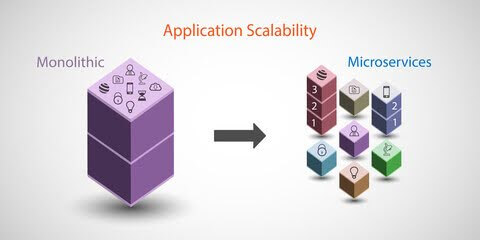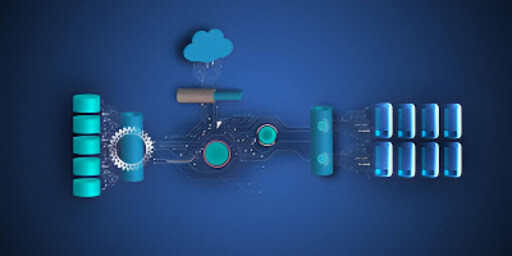 1-800-805-5783
1-800-805-5783 
Businesses always attempt to stay ahead of the competition in today’s fast-paced digital market by offering their clients cutting-edge, scalable solutions. A game-changer, microservices architecture promises better agility, higher scalability, and improved development efficiency. However, the path to adopting microservices has its share of difficulties.
In this article, we will explore the nuances of microservices adoption, covering the challenges businesses encounter while switching to a microservices design. We’ll explore the major obstacles that can make or break your microservices journey, from the problems of decomposing monolithic apps to managing microservices at scale.
In the context of software development and microservices architecture, Microservices refers to a modular and decentralized approach to building and organizing software applications.
This architectural style involves separating complex applications into independently deployable and manageable services, each focusing on a specific business capability or function. These services, often referred to as “microservices,” are optimized for scalability, flexibility, and maintainability, and they communicate with each other through well-defined APIs (Application Programming Interfaces).
Microservices architecture encourages breaking down large, monolithic programs into more minor, independent services that may be created, deployed, and scaled separately.
This strategy allows development teams to work on many microservices simultaneously, resulting in shorter development cycles and greater agility.
Additionally, microservices enable various databases, technologies, and programming languages for each service, allowing the best tools to meet each component’s unique needs.

Modern methods for creating and developing software applications, such as microservices architecture, have recently become popular. Because of its importance in multiple essential areas, it is an appealing option for many firms looking to enhance their systems and processes. Some of the critical features of microservices architecture are listed below:

Adopting microservices architecture presents numerous challenges as organizations transition from traditional monolithic systems to a more modular and decentralized approach.
Here are some key challenges:
A. Complexity:
B. Scalability:
Elasticity and Resource Management: Microservices architectures are designed to be scalable and dynamic, allowing individual services to be scaled independently based on demand.
However, achieving proper elasticity and efficient resource management can take time and effort. Organizations must implement auto-scaling mechanisms that allocate and deallocate resources for each microservice based on real-time usage patterns.
Load Balancing: In a microservices environment, multiple instances of each service are often running to handle varying loads. Proper load balancing is essential to distribute incoming requests evenly across these instances.
Distributed Data Management: Microservices often have their own databases or data storage solutions to maintain data autonomy. Managing data in a distributed environment can be complex.
C. Security
API Security: Microservices rely heavily on APIs for communication between various services. While APIs facilitate flexibility and modularity, they also introduce potential security vulnerabilities.
Each API endpoint must be secured to prevent unauthorized access, data breaches, or injection attacks. Implementing proper authentication mechanisms, rate limiting, and input validation are crucial to safeguarding the microservices ecosystem.
Data Privacy: Microservices typically handle sensitive data, which could be exposed or compromised if not adequately protected. Ensuring data privacy becomes complex when data is distributed across multiple services. Microservices must enforce strict access controls, encryption, and data masking to prevent unauthorized access and data leaks.
Authentication and Authorization: Managing authentication and authorization in a microservices environment can be challenging. Each service must verify the identity of incoming requests and determine whether the requester has the necessary permissions to access specific resources. Implementing a centralized identity management system and fine-grained access control policies can help mitigate these challenges.
D. Monitoring and Debugging:
Distributed Tracing: Microservices applications comprise numerous small services that communicate with each other over a network. When a problem occurs, tracing the flow of requests across these services can be challenging.
Distributed tracing tools are essential for visualizing and tracking requests as they move through the microservices ecosystem. Implementing and maintaining distributed tracing can be resource-intensive and requires standardized team practices.
Log Management: In a microservices environment, each service generates its logs. These logs are valuable for debugging and monitoring, but managing them can become overwhelming as the number of services increases.
A centralized approach to log management can facilitate correlation events, troubleshoot issues, and maintain a coherent view of the system’s health. Implementing a comprehensive log management strategy that covers all microservices is crucial.
Performance Monitoring: Microservices systems can experience performance bottlenecks that are hard to identify and address. Each microservice may have different resource requirements and dependencies, making it challenging to pinpoint performance issues.
Monitoring the performance of individual services and the entire system is essential for ensuring optimal performance. However, configuring performance monitoring tools and establishing meaningful metrics for each microservice can be complex.
E. Cultural and Organizational Challenges:
The shift in Development Culture: Adopting microservices requires a fundamental change in an organization’s development culture. Traditional monolithic development follows a linear process, while microservices thrive on agility and decentralization.
To maximize microservices, developers must embrace a culture of experimentation (CI/CD). This cultural transformation can be met with resistance, especially in organizations that have relied on monolithic systems for years.
Cross-functional Teams: Microservices development necessitates cross-functional teams with diverse skill sets. Instead of having separate sections for front-end, back-end, and database, microservices projects often require engineers proficient in multiple areas.
This change can be challenging as it involves hiring the right talent, restructuring existing teams, and fostering a culture of collaboration. Developers must be capable of working across the entire software stack, from infrastructure to user interface, to effectively build and maintain microservices.
Communication and Collaboration – Microservices Optimized: Effective communication and collaboration are paramount when working with microservices. Each microservice typically has its codebase, database, and API, making it crucial for teams to collaborate seamlessly. Developers must understand the interdependencies between microservices and communicate changes effectively.
Furthermore, optimizing communication channels and tools for microservices is vital. Implementing robust version control, API documentation, and monitoring systems becomes essential to ensure that changes in one microservice do not disrupt the functionality of others.
Fostering a culture of shared responsibility and accountability for microservices can also help prevent communication breakdowns.

Microservices architecture has gained prominence in recent years due to its scalability and flexibility, but its successful adoption comes with challenges. To navigate these challenges and optimize your microservices architecture, consider the following design principles:
Domain-Driven Design (DDD): Embrace Domain-Driven Design to align your microservices with specific business domains. This approach encourages a clear understanding of your business processes and helps define microservices boundaries, ensuring they are closely aligned with the functionality they serve. DDD enhances the cohesiveness of microservices and simplifies their maintenance.
Single Responsibility Principle (SRP): Rigorously apply the SRP when designing your microservices. Each microservice should have a well-defined and singular responsibility, focusing on a specific business capability or feature.
This principle ensures that your microservices remain small, cohesive, and maintainable, making scaling and evolving them independently easier.
Containerization (e.g., Docker): Containerization plays a pivotal role in successfully implementing microservices. Leveraging containerization tools like Docker helps encapsulate microservices and their dependencies into lightweight, portable units. The approach simplifies microservices’ deployment, scaling, and management, enabling them to run consistently across diverse environments.
Service Mesh (e.g., Istio): A service mesh is a fundamental component in a microservices ecosystem. It provides essential features like service discovery, load balancing, and security for microservices.
Istio, a popular service mesh solution, offers advanced traffic management capabilities, making it easier to handle the complexity of microservices communication. By implementing a service mesh like Istio, organizations can enhance the reliability and observability of their microservices architecture.
API Gateway (e.g., Kong): Microservices rely on APIs for communication, and managing these APIs is vital for a successful microservices architecture. An API Gateway, such as Kong, is a central point for managing, securing, and monitoring API traffic.
It simplifies API versioning, authentication, and rate limiting, crucial aspects of microservices development. An API Gateway like Kong helps organizations maintain control and visibility over their microservices-based applications.
Container Orchestration (e.g., Kubernetes): Containerization is a core technology in microservices development. It enables the packaging of microservices into lightweight, isolated containers. Kubernetes, a leading container orchestration platform, streamlines containerized microservices’ deployment, scaling, and management.
It offers automated scaling, self-healing capabilities, and efficient resource utilization. Kubernetes ensures that microservices run consistently and reliably, making it an essential tool for microservices adoption.
Embracing microservices’ best practices is essential for a smooth transition. This involves decomposing monolithic applications into more minor, manageable services and ensuring each microservice has a well-defined scope and clear boundaries.
Implementing containerization and orchestration technologies like Docker and Kubernetes can enhance flexibility and scalability. Adopting continuous integration and continuous delivery (CI/CD) pipelines also streamlines development and deployment processes.
Ensuring the security of microservices is paramount. Implement robust security measures, such as container security scanning, role-based access control, and data encryption at rest and in transit.
Employing API gateways and microservices firewalls can protect against unauthorized access and attacks, while regular security audits and penetration testing help identify vulnerabilities and mitigate risks.
Effective monitoring and observability are critical for maintaining the health and performance of microservices. Implement centralized logging and distributed tracing to gain insights into service interactions and detect issues promptly.
Utilize monitoring tools and dashboards to track key performance indicators (KPIs) like response times, error rates, and resource utilization. Proactive monitoring allows for timely troubleshooting and optimization of microservices.
Microservices adoption requires organizational alignment and cultural shifts. Promote cross-functional teams that take ownership of specific microservices, fostering a sense of responsibility and accountability.
Encourage collaboration between development, operations, and security teams to break down silos and ensure smooth coordination. Establish clear communication channels and documentation practices to facilitate knowledge sharing and maintain a unified vision for microservices architecture.

Case Study 1: Netflix
Microservices Adoption: Netflix is a prime example of successful microservices adoption. In the early 2000s, they transitioned from a monolithic architecture to a microservices-based one to enhance scalability and innovation.
Real-world Example: Netflix’s recommendation system relies heavily on microservices. It has separate services for content recommendation, user authentication, content delivery, and more. This architecture allows Netflix to independently update and scale each component, resulting in a highly personalized and efficient streaming experience.
Lessons Learned:
Case Study 2: Uber
Microservices Adoption: Uber’s journey to microservices began in 2014 when it faced challenges scaling its monolithic architecture to meet growing demand.
Real-world Example: Uber’s dispatch system is a critical microservice. It manages ride requests, driver allocation, and real-time updates. By breaking down their system into microservices, they improved geographical precision and reduced response times.
Lessons Learned:
Case Study 3: Amazon
Microservices Adoption: Amazon, one of the pioneers of microservices, has a vast and complex ecosystem of services powering its retail and cloud infrastructure.
Real-world Example: Amazon Web Services (AWS) is a prime example of microservices architecture. AWS offers hundreds of services, each fulfilling a specific function, such as storage (S3), compute (EC2), and databases (RDS). Customers can use these services independently, promoting flexibility and scalability.
Lessons Learned:
Case Study 4: Airbnb
Microservices Adoption: Airbnb started its microservices journey to tackle scalability challenges in its booking platform.
Real-world Example: Airbnb’s search and recommendation system is powered by microservices. It offers services for real-time pricing, search indexing, and personalized recommendations. This architecture enables Airbnb to handle a massive volume of user searches efficiently.
Lessons Learned:
In conclusion, embracing microservices architecture is a transformative journey for modern businesses seeking agility, scalability, and enhanced efficiency in their software development and deployment processes. However, understanding the challenges of adopting microservices is crucial to successfully navigating this path.
As we’ve explored, some key challenges in adopting microservices include managing complexity, ensuring effective communication between microservices, handling data consistency, and addressing security concerns. To overcome these hurdles, organizations must prioritize careful planning, robust architectural design, and the implementation of best practices.
To thrive in a microservices-driven landscape, businesses should invest in comprehensive training and skill development for their development and operations teams. Additionally, embracing technologies such as containerization and orchestration (e.g., Docker and Kubernetes) can simplify the deployment and scaling of microservices, promoting a smoother transition.
Moreover, fostering a culture of collaboration and continuous improvement within the organization is vital. Encouraging cross-functional teams, adopting DevOps practices, and regularly reviewing and refining the microservices architecture can lead to ongoing optimization and success.
Despite the difficulties of adopting microservices, businesses that commit to identifying, resolving, and overcoming these obstacles will be better prepared to benefit from the many advantages of this avant-garde architectural strategy. By mastering the complexities of microservices, businesses may improve their agility, scalability, and overall competitiveness in today’s fast-paced technology market.
[x]cube LABS’s teams of product owners and experts have worked with global brands such as Panini, Mann+Hummel, tradeMONSTER, and others to deliver over 950 successful digital products, resulting in the creation of new digital revenue lines and entirely new businesses. With over 30 global product design and development awards, [x]cube LABS has established itself among global enterprises’ top digital transformation partners.
Why work with [x]cube LABS?
Our co-founders and tech architects are deeply involved in projects and are unafraid to get their hands dirty.
Our tech leaders have spent decades solving complex technical problems. Having them on your project is like instantly plugging into thousands of person-hours of real-life experience.
We are obsessed with crafting top-quality products. We hire only the best hands-on talent. We train them like Navy Seals to meet our standards of software craftsmanship.
Eye on the puck. We constantly research and stay up-to-speed with the best technology has to offer.
Our CI/CD tools ensure strict quality checks to ensure the code in your project is top-notch.
Contact us to discuss your digital innovation plans, and our experts would be happy to schedule a free consultation.